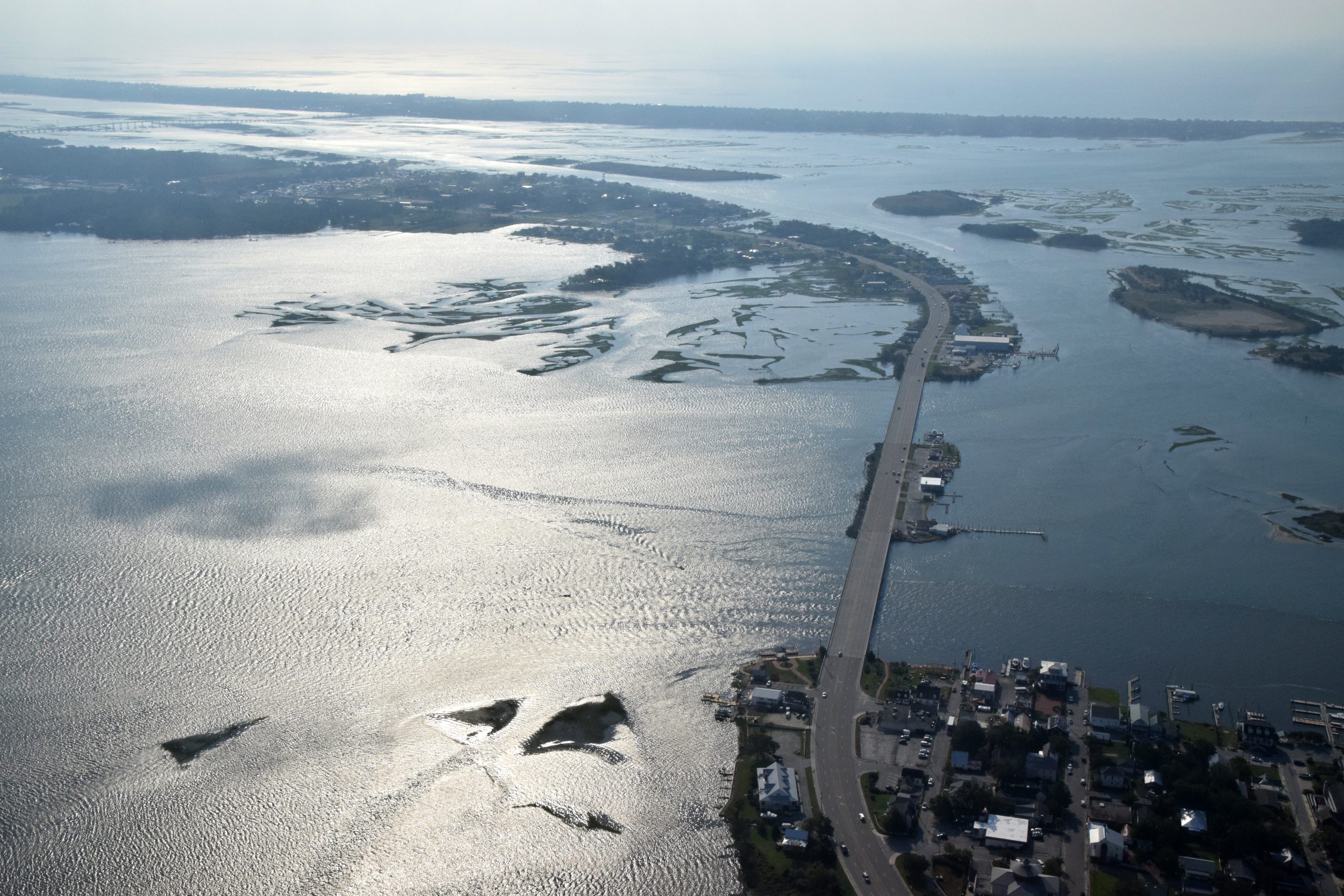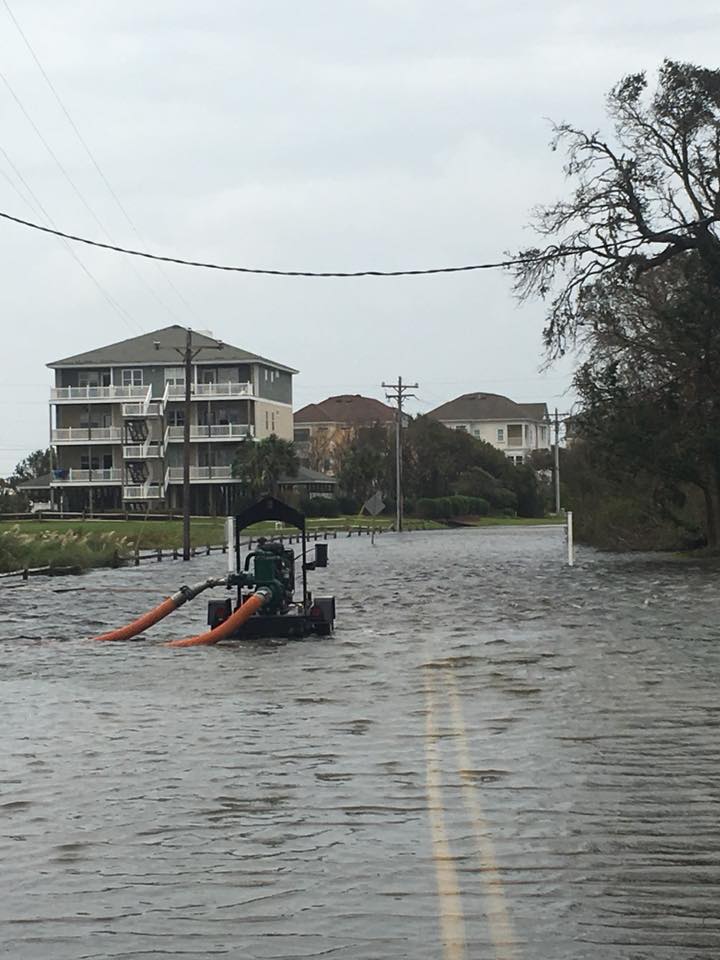
This is the fifth installment in a continuing series on making the North Carolina coast more resilient to the effects of climate change, a special reporting project that is part of the Pulitzer Center’s nationwide Connected Coastlines initiative.
Twenty-five coastal communities will have money from the state to better prepare for natural hazards.
Supporter Spotlight
The funding is geared to drive better-informed decision making at the local level and initiatives that reduce risk and vulnerability to flooding, storms and other effects of climate change.
The North Carolina Department of Environmental Quality’s Division of Coastal Management announced March 17 a total of $675,000 would be granted through the new Resilient Coastal Communities Program, launched in the fall to provide technical and financial help to governments in the state’s 20 coastal counties to develop resilience efforts. The application deadline was Jan. 15.
“We wish we had the funding to have accepted all interested communities into the program, but we hope to secure additional funding to offer another round of Phase 1 and 2 funding in the future,” Sam Burdick, coastal resilience coordinator with the Division of Coastal Management, recently told Coastal Review. The division received 30 applications representing 32 coastal communities — one application was submitted by three communities — for the first two phases of grant funding.

“Building resilience to natural hazards is vital for communities to help maintain quality of life, healthy growth, durable systems, and conservation of resources for present and future generations,” Burdick explained. “However, a number of barriers to developing resilience to coastal risks exist, including economic and capacity constraints that have been exacerbated in recent times. Building more resilient communities requires careful, thorough planning efforts using sound, locally relevant data.”
Burdick is from Duck on the Outer Banks and has a background in coastal science, policy, ecology, local and regional planning, and community outreach. Before joining the division, Burdick was the community planner and disaster recovery coordinator for the Eastern Carolina Council of Governments. She has been the coastal resilience coordinator with the division in Morehead City since February 2020 and is tasked with leading the development and implementation of the Resilient Coastal Communities Program.
Supporter Spotlight
The program is rolling out in four phases: community engagement and risk and vulnerability assessment; planning, project selection and prioritization; project engineering and design; and implementation. The initial funds are to be used for the first two phases.
Community applications were scored across seven criteria, including the level of risk exposure to vulnerable populations and critical assets, economic status and need, and internal capacity and momentum with related efforts, according to the state.
The towns of Aurora, Beaufort, Belhaven, Cape Carteret, Hertford, Leland, Navassa, Sunset Beach, Surf City, Topsail Beach, North Topsail Beach, Vandemere, Washington and Windsor are to receive technical assistance to complete Phases 1 and 2.

Barnes Sutton, town planner in Navassa in Brunswick County, explained Tuesday that urban planning and design were once guided by the natural forces in a given area, such as navigable waters or the direction of prevailing winds, allowing cities to optimize those natural resources and by extension protect those resources.
“This created unique places that balanced city centers and residential areas with communal space and fields for agriculture,” Sutton said. He added that at some point, urban planning moved away from these principles and began to emphasize consumption over conservation.
“Being selected to participate in the Resilient Coastal Communities Program underlines the importance of natural resources and how to grow with sustainability and recyclability in the forefront, which in time, can undo the damages over-consumption has done,” Sutton said. “Navassa is poised to support exponential growth in residential, commercial and recreational sectors over the next five years, all of which will need healthy and efficient waterways to support it and will only be magnified by the restoration and protection of them.”
Beaufort in Carteret County also received a grant. Town Planner Kate Allen told Coastal Review Tuesday that storm surge and the heavy rainstorms and higher tides of recent years pose acute risks to life and property, particularly during hurricane season.
“In 2018, Hurricane Florence wreaked havoc on the town and surrounding areas. Heavy rains coupled with high tide results in frequent flooding of Front Street. Shoreline erosion, primarily caused by rising water levels and storms, increases the town’s flooding risk. These stressors individually pose risk, but are most impactful when they occur together, and often they do,” she said. “As a small community, town staff lack the time necessary to conduct thorough vulnerability and risk assessments. This grant will allow the town to place more emphasis on the risk and vulnerability assessment included in the ongoing CAMA/Comprehensive Land Use Plan update.”

The division also selected the counties of Beaufort, Craven, Currituck, Dare for Hatteras Island, Hertford, Hyde and Pamlico for the program.
Dare County Manager Bobby Outten said Tuesday that the county received a $30,000 grant through the program to study all risks and vulnerabilities on Hatteras Island. These include economic vulnerabilities, storm vulnerabilities, transportation vulnerabilities and any others that the consultant determines exist.
“Completion of this study would make Dare County eligible for additional grants to determine remedies to resolve or mitigate the vulnerabilities found,” Outten said. “Once the remedies are determined, Dare County would be eligible for yet another grant to begin implementing those remedies.”
Duck, Nags Head, Swansboro and Pine Knoll Shores have shown significant momentum in resilience planning and have been selected to complete the remaining requirements of the first two phases, the division said in the March 17 announcement.
Burdick said big barriers for communities when it comes to planning is the lack of a dedicated resilience budget, an overall reduced budget related to the economic effects of the pandemic, and a lack of capacity to plan.
A more proactive, sustainable and equitable approach to risk planning focuses on mitigating or reducing vulnerability, rather than responding after storms or flooding, she said.
The resilience program is a priority in the state’s Climate Risk Assessment and Resilience Plan and reflects Gov. Roy Cooper’s commitment to building climate change resiliency statewide while promoting economic growth and stability. It’s the product of a series of resilience efforts and events the division led in recent years to address intensifying natural hazards on the coast, Burdick said.
The division worked with five local governments from 2017 to 2018 using a process called Resilience Evaluation Needs Assessment, or RENA, to map critical assets and assess risk and vulnerability to coastal hazards.
After Hurricane Florence in 2018, Cooper signed Executive Order No. 80, calling for the development of the North Carolina Climate Risk Assessment and Resilience Plan. The state held several workshops in 2019, including in Elizabeth City and Wilmington, to ensure the plan was based on local knowledge and needs, she said.

The 2020 Climate Risk Assessment and Resilience Plan called for the development of the Resilient Communities Program, which was designed to boost resilience building at the local level with a three-pronged approach: local government funding, training and capacity building and an online resilience portal. The Resilient Coastal Communities Program falls under the larger umbrella of the statewide North Carolina Resilient Communities Program, Burdick explained.
The division received about $830,000 in funding from the North Carolina General Assembly and $1.1 million from the National Fish and Wildlife Foundation this year to begin developing and implementing the resilience framework for local governments.
Partnering with the North Carolina Office of Recovery and Resiliency, North Carolina Sea Grant and The Nature Conservancy, the division tailored a number of resilience plans from other states to needs specific to coastal North Carolina communities.
Division Director Braxton Davis said division partners and coastal communities have been working on various aspects of coastal resilience for a long time, but lacked a clear framework to help organize efforts.
“This new program will help all of us become more efficient and strategic in our investments, ensure that we are identifying and prioritizing the most important projects, and provide more targeted technical assistance that builds on previous planning efforts,” Davis said. “DCM is proud to lead this effort on behalf of our coastal communities and appreciates the ongoing partnerships we have with the N.C. Office of Recovery and Resiliency, The Nature Conservancy, and N.C. Sea Grant.”
The resilience team held two interactive webinars in August 2020 to introduce the Resilient Coastal Communities Program and the funding opportunities targeted to local governments, consultants, academia and nongovernmental organizations. A total of 225 attendees participated in these webinars, including representation from 18 county governments and 39 municipal governments.
A virtual discussion with more than 50 contractors interested in providing services to communities through this program was held in September 2020. There were 24 contractor applications for Phases 1 and 2.
“Understanding the importance of inclusivity and equity in planning processes, participating local governments and contractors will develop a Community Action Team, or steering committee, and a community engagement strategy to involve community members and local leaders throughout the process,” Burdick said. “Local knowledge and feedback are key and will help inform the process and drive the development of sound, feasible projects and action items to enhance resilience.”
Next in the series: Natural and working lands







